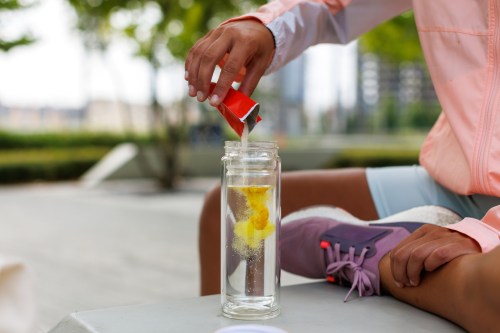Here’s How Your Body Is Telling You You’re Not Eating Enough Iodine
A dietitian shares the key iodine deficiency symptoms to look out for, and provides a lost of iodine-rich foods to stock up.

Of course, getting the essential vitamins and minerals your body needs is a key part of maintaining optimal health and feeling your best. And while there’s tons of information on meeting the recommended daily allowance of important nutrients like vitamin D and calcium, it’s also important to meet our iodine needs to help our thyroid function properly.
Experts in This Article
registered dietitian and owner of The Flourished Table
Thanks to the mineral levels in the food supply, iodine deficiency in the United States is uncommon. Even then, knowing how your body may signal you need more iodine in your diet is always something to learn. For that reason, we spoke with a registered dietitian nutritionist to explain how your body may signal you need more iodine with a list of the top food sources.
What to know about iodine
Before getting into iodine deficiency, let’s first cover what is iodine and why it matters for our thyroid health. “Iodine is a trace element naturally found in foods like fish and seaweed essential for the production of thyroid hormones,” says Elise Harlow, MS, RDN, a California-based registered dietitian nutritionist and founder of the Flourished Table. “Iodine is [also] involved in all the cells in our body and necessary for normal cell functioning, thyroid functioning, and fetus and infant development.” Our bodies cannot make iodine on its own, so it’s essential to get it through dietary sources.
The Recommended Daily Allowance (RDA) for iodine for the general public is 150 mcg, 220 mcg for pregnant women, and 290 mcg for breastfeeding women. The RDA for pregnant and breastfeeding women requires more iodine due to the increased maternal thyroid production, increased renal iodine losses, and transfer of iodine to the baby.
“It’s relatively easy to meet your iodine needs by eating iodine-rich foods, but there are certain cases where you may be more at risk of being deficient in iodine,” says Harlow. “For example, if you’re vegan or vegetarian or remove iodized salt from your seasoning rotation, then this can reduce your overall iodine consumption.”
In those cases, you can always request to get tested for iodine deficiency by your primary doctor with a urine sample. However, Harlow affirms this isn’t something to stress about as iodine deficiency is rare, especially if you’re already taking a multivitamin that contains iodine.
The most common iodine deficiency symptoms to chat with a doctor about
“The first sign of iodine deficiency can be a suboptimal functioning thyroid, where the thyroid is beginning to produce less thyroid hormones but not quite to the point where medical doctors would diagnose clinical hypothyroidism and prescribe medication,” Harlow says. “Most functional and integrative medical doctors will then recognize suboptimal thyroid function and do further testing to determine if iodine deficiency may be contributing to the poor thyroid function.”
If left untreated, this can lead to clinical hypothyroidism—a condition where your thyroid gland doesn’t produce enough thyroid hormones—and then to goiter, which is an enlargement of the thyroid gland that can look like swelling in the neck area. Other early warning signs of thyroid problems can include weight changes, fatigue, and gut issues. “When there’s not enough iodine [in the body], your thyroid isn’t able to produce the hormones used for multiple different functions, which causes it to enlarge in an attempt to search for more iodine to be able to make thyroid hormone,” Harlow says. This can often look like swelling in the neck or feeling tightness in your throat area.
“Other examples of iodine deficiency are pregnancy-related problems like congenital abnormalities and preterm delivery,” says Harlow. She recommends asking your primary doctor to get tested for iodine deficiency if you experience swelling in the neck or are just curious about thyroid functioning.
6 food sources of iodine
As luck would have it, Harlow list of iodine-rich foods she recommends adding to your diet is packed with delicious ingredients. (Just keep in mind as you read over them that the intake percentages are based on the RDA for the general public and not for women that are pregnant women or currently breastfeeding.)
1. Iodized salt: The most common way to consume iodine is through iodized salt, a version of salt created in 1924 to prevent goiter and iodine deficiency. “In one teaspoon of iodized salt, there are 400 mcg of potassium iodide, which is the carrier for the iodine,” Harlow says. “However, it’s important to note that the iodine content reduces by 50 percent one to two months after exposure to the air.”
2. Seaweed: Not only does seaweed contain fiber linked to gut-boosting benefits, but it’s also considered a great source of iodine. “Two tablespoons of seaweed is about 115 mcg of iodine, which is about 80 percent of the RDA,” says Harlow.
3. Oysters: Oysters may not be everyone’s cup of tea, but they offer about 90 mcg of iodine in three ounces of oysters, which is around 60 percent of daily needs.
4. Cod: There are 160 mcg of iodine in three ounces of cod, which is just over 100 percent of the daily needs.
5. Greek yogurt: Greek yogurt is a great way to get in your iodine intake, especially if you’re not a fan of seafood. “Three cups of Greek yogurt has 90 mcg of iodine or 60 percent of the daily needs,” says Harlow. You can have Greek yogurt with fruit and your favorite granola as a snack or as your morning breakfast.
6. Eggs: One egg contains 25 mcg of iodine (20 percent of the RDA), so if you use two eggs for your morning omelet, you’re already getting 50 grams of iodine alone.
The bottom line? Iodine deficiency probably isn’t something to stress over, especially if you’re already consuming several foods from the list above. If iodine deficiency is something you’re curious about, you can always request to get a urine test to look for the deficiency by your primary physician. Harlow also advises chatting with a doctor or dietitian about taking a multivitamin to fill in the nutrient gaps, if you’re not taking one already.










